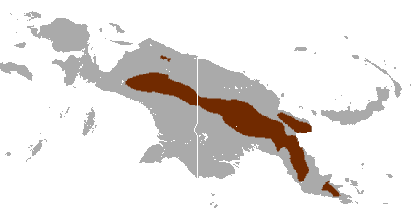針鼴(Echidna)之特性及種類
針鼴在分類上和鴨嘴獸均屬於哺乳綱單孔目
脊索動物門(Phylum Chordata)
脊椎動物亞門(Subphylum
Vertebrate)
哺乳綱(Class Mammalia)
單孔目(Order Monotreme)
但是牠們之間還是有些差異。
一、鴨嘴獸與針鼴之比較表
|
名 稱
|
鴨嘴獸(Platypus)
|
針鼴(Echidna)
|
|||||||||
|
種類以及棲所(habitat)
|
一種(Ornithorhynchus anatinus)
棲所:澳洲東部及Tasmania島
|
四種
1.短吻針鼴(Tachyglossus aculeatus)
棲所:澳洲、紐幾內亞島
2.西方長吻針鼴
3.東方長吻針鼴
4.大衛爵士長吻針鼴
※2.3.4.之棲所:紐幾內亞島
|
|||||||||
|
哺乳類之分類
|
屬於卵生哺乳類
(oviparous mammal)
|
屬於卵生哺乳類(oviparous mammal)
|
|||||||||
|
雌性一次產卵數
|
2粒
|
1粒
|
|||||||||
|
習性
|
夜行性 水棲
|
夜行性 陸棲
|
|||||||||
|
主要獵物
|
水中無脊椎動物
|
蚯蚓、螞蟻、白蟻等昆蟲
|
|||||||||
|
偵測獵物的方法
|
鴨嘴上靈敏的
1.電流接受器(electroreceptors) 40,000個
2.機械接受器(mechanoreceptors)
|
嗅覺以及口鼻部的
電流接受器(electroreceptors)
400〜2,000個
|
|||||||||
|
身長體重
|
|
短吻針鼴
身長:30~45公分
體重:2.0~5.0公斤
長吻針鼴
身長60~100公分
體重5~10公斤
|
|||||||||
|
嘴中
|
無牙齒
|
無牙齒
|
|||||||||
|
存活年齡
|
~15年
|
~50年
|
|||||||||
|
體溫維持於
|
32℃
|
30℃〜32℃
|
|||||||||
|
雄性後肢腳踝處具有距(spur)
|
距為中空能分泌毒液
|
毒腺無功能,無法分泌毒液
|
二、針鼴現存有四種:
三種的棲所(Habitat)在紐幾內亞島(New
Guinea)的高地森林底層,以蚯蚓及其牠昆蟲為食。
三種棲所在紐幾內亞島的針鼴分別是:
1.
西方長吻針鼴(Western long-beaked echidna ,Z. bruijni),
棲所在紐幾內亞島高地森林中。
2. 東方長吻針鼴(Eastern
long-beaked echidna ,Z. bartoni)。
3.
大衛爵士長吻針鼴(Sir David’s long-beaked echidna,Z. attenboroughi),只有在1961年於紐幾內亞島高地發現一件標本。
4.
短吻針鼴(Tachyglossus aculeatus)的棲所在:澳洲、紐幾內亞。
圖01. 短吻針鼴(Tachyglossus aculeatus),棲所位於澳洲以及巴布亞紐幾內亞(Papua
New Guinea)。以螞蟻、白蟻為主食。體表除了針狀突起以外具有毛髮(fur),而毛髮(fur)是哺乳動物才有的特徵。
圖02. 短吻針鼴(Tachyglossus aculeatus)-2,棲所位於澳洲以及巴布亞紐幾內亞(Papua
New Guinea)。
圖03. 西方長吻針鼴(Western Long-Beaked Echidna),棲所位於巴布亞紐幾內亞(Papau
New Guinea)的高地密林中。以蚯蚓或其他昆蟲為食。
圖04. 西方長吻針鼴(Western Long-Beaked Echidna)─2。
圖05. 東方長吻針鼴,前肢五趾,後肢四趾,體重5~10公斤,體長60~100公分,無尾巴。
圖06. 東方長吻針鼴的分佈範圍,棲所(Habitat)位於紐幾內亞島2,000~3,000公尺高地。
圖07. 大衛爵士長吻針鼴,此為1961年以來唯一發現的一具標本。
Sir
David's Long-beaked Echidna (also
known as the Cyclops Long-beaked Echidna, after the mountain range where it
lives) was previously known from a single specimen collected in 1961 (shown
here).
圖08. 大衛爵士長吻針鼴的棲所範圍,位於Cyclops Mountains。
三、針鼴的特徵:
1. 短吻針鼴具有有力的四肢及堅強的爪,是有效的挖掘者。
2. 針鼴前方皆有著細長的口鼻部,同時具有口和鼻的功能。雖然牠
們嘴中沒有牙齒但能撕開軟木或蟻丘,然後以長而具有黏性的舌
頭,捕獲獵物。
3. 針鼴的嘴巴開口在口鼻部的尖端,因此張嘴的程度最多無法超過0.5公分。
4. 針鼴的胃液與一般哺乳動物不同,非酸性而是近乎中性,pH值在6.2〜7.4之間。
5. 生活在澳洲及紐幾內亞島的短吻針鼴以螞蟻、白蟻為食;而生活在紐幾內亞島上之三種針鼴則以蚯蚓或其他昆蟲為食。
6. 針鼴平常維持體溫在30℃〜32℃的恆溫,當嚴冬時會進入蛰伏(Torpor)狀態,那時的體溫只有5℃左右。
7. 針鼴與鴨嘴獸都有能力感應獵物的電流:
(1.) 鴨嘴獸的喙部具有40,000個電流接受器(electroreceptor);
(2.) 針鼴的口鼻部只有400〜2,000個電流接受器,
因此鴨嘴獸對獵物(preys)的靈敏度較高。
8. 鴨嘴獸和鯨豚類是已知少數無快速動眼睡眠期(=作夢期)的哺乳類動物。針鼴則只有當睡眠溫度為25℃時,才會產生快速動眼睡眠(Rapid Eye Movement, REM),睡眠溫度過高或過低REM睡眠均無法形成。
顯然小小的針鼴,還有許多我們尚待研究的秘密,不過那麻煩學者專家吧。網友們只希望您看到針鼴的照片時,請別跟紐西蘭的國鳥Kiwi鳥、食蟻獸(Anteater)、刺蝟(Hedgehog)互相混為一談就好!
圖09. 針鼴與Kiwi鳥、食蟻獸、刺蝟四者您分得清楚嗎?
|
短吻針鼴的圖出現在澳大利亞5分的硬幣上。
圖10. 短吻針鼴的圖出現在澳大利亞五分錢上。
|






















